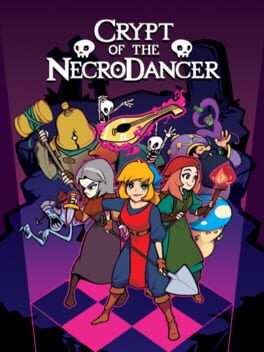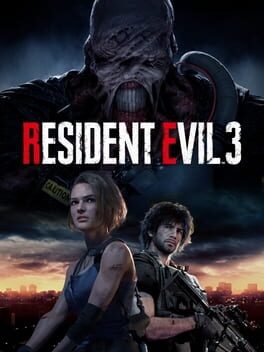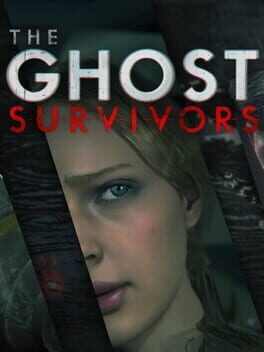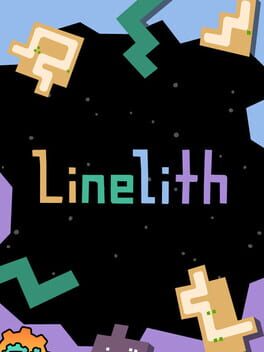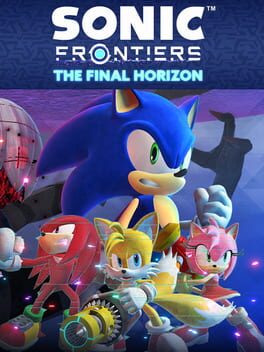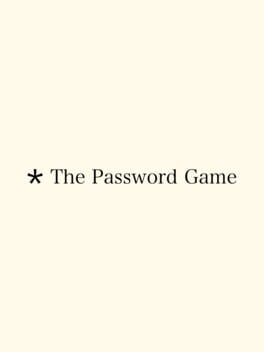Plasmatize
Bio
Lifelong video game superfan, enthusiast and overthinker. On a perpetual journey of discovery.
Lifelong video game superfan, enthusiast and overthinker. On a perpetual journey of discovery.
Badges

GOTY '23
Participated in the 2023 Game of the Year Event

Donor
Liked 50+ reviews / lists

Liked
Gained 10+ total review likes

Best Friends
Become mutual friends with at least 3 others

Noticed
Gained 3+ followers

Gamer
Played 250+ games

2 Years of Service
Being part of the Backloggd community for 2 years

N00b
Played 100+ games
Favorite Games
378
Total Games Played
028
Played in 2024
047
Games Backloggd
Recently Played See More
Recently Reviewed See More
You can beat this game in around an hour, so stop reading backloggd reviews and just play it! What's the worst that can happen? You waste $3 and 1/5 of an evening? Chances are that won't happen though, as this blend of simplicity, cleverness, and quick, intuitive, satisfying puzzles is worth every penny and every second! It's basically The Witness-esque line puzzles condensed into its most refined form. Saying any more would just spoil the fun, as the game's surprises and elegance largely speak for themselves. The very definition of short but sweet!
Disclaimer: I've only played 1 of the new Cyberspace stages so far, so I'll mainly be focusing on all the other content here. TL;DR: consider giving this DLC a shot if you liked Frontiers, but found yourself craving more of a challenge. Just be prepared to hit a lot of speed bumps on the way.
I came away from The Final Horizon with mixed, conflicting thoughts. In some ways, it’s a step in a worthy direction, with much more demanding, less-automated platforming, combat and minigame challenges that make good use of both new and old mechanics. On paper, it’s something fans have been clamouring for in modern Sonic games, and Frontiers specifically. It’s the sort of thing that could have elevated Frontiers’ formula to its full potential! But alas, we get mere glimpses of this on the horizon of a sea of minor to major annoyances.
The biggest issue putting a glass ceiling on things is simply a lack of refinement or situational considerations in general. The thing about cranking up the challenge and gameplay stakes is that, while often necessary to more deeply and richly explore game systems and mechanics, and a powerful tool to push players to do so in turn, it also brings more potential for frustration or irritation with the game if things aren’t quite as polished as they need to be. This DLC is unfortunately a victim of this effect, much more so than the (comparatively) polished and easygoing main game.
For instance, it turns Amy, Knuckles and Tails into new playable characters, but they all spend most of the runtime so poorly-equipped for combat, that you’re better off avoiding most of it to just eventually come back with Sonic, whom most of the combat still feels designed around. The exception is an unlockable ability for Tails, but it’s unlikely most players will reach this point for a good chunk of the DLC. As for platforming, these new characters are all much more slippery/sluggish/cumbersome to control compared to the inherent joy of controlling Sonic, which again, limits the excitement factor. It also occasionally leads to annoyances due to the precision required for certain challenges, though I'd say only Knuckles is substantially affected by this.
Two signature moves of his are gliding and climbing (certain) walls; both abilities get frequent use, but include needless annoyances. While gliding in the presence of objects, the camera occasionally has a tendency to be uncooperative, or swing or jump unexpectedly and throw you off course at inopportune moments. Moreover, when pressing the glide button, Knuckles strangely floats in the air for a second, as if to awkwardly “charge up” a glide. During this, Knuckles can turn verrrrrrry slowly in the air, but since gliding normally has a somewhat wide turning radius, losing height in the process, it’s often beneficial to repeatedly press and release the glide button before starting the glide to slowwwwly turn around midair. Regardless of how silly this looks, none of Knuckles’ challenges explicitly require this. However, its inclusion gives the player an opportunity to recover from minor mistakes (or of camera misbehaviour), and ample incentive to do so, only to make the process very slow and annoying to execute. Whether this was intentional tech or not, it's safe to say that either an instant turnaround from the windup, or removing the long windup altogether, would have made the whole thing feel smoother.
As for wall climbing, it also has limited turn speed; there’s a certain radius of curvature that Knuckles has to follow to change direction. What’s strange though is that moving slowly, the instinctive approach to advancing with caution/precision, doesn’t seem to decrease this radius at all. In fact, even if you stop moving completely, this radius and starting direction continues from whichever direction you were last moving. To try my best to illustrate this with just text, suppose you’re moving to the right, then stop moving to avoid an upcoming hazard. Then, after stopping, you press left to go back the way you came. Intuitively, one would expect Knuckles to climb to the left. Instead, he’ll start moving to the right, full speed, and make a little half-circle either up or down to wrap around to moving left. By now, you probably hit that hazard you stopped to avoid, and lost progress because of it. not due to insufficient skill or reflexes, but due to a quirk of the movement that makes no sense either intuitively or mechanically. There were a few sections with Knuckles where the movement/timing precision expected made this a nuisance, but in general, it just feels off.
All of these movement issues are things a player can eventually learn to avoid or work around, bringing character actions more in line with player expectations or intent, but they’re examples of how unpolished, imprecise, and even unintuitive the movement can feel, and how this hinders the game’s attempts at more difficult or precise platforming challenges. Fortunately, these issues are much less prevalent with Tails or Amy; Tails’ flight height gain delay is the only other minor example of needless sluggishness off the top of my head, and not one that tends to cause knock-on problems.
As for Sonic, he still controls just as smoothly as in the base game, and probably has the best platforming gameplay overall. This primarily takes the form of tower climbing, similar to Rhea Island from the base game, but with a cranked up challenge level. and fewer automated sections. These sections seem divisive, but I’m going to make a case for them here. As mentioned, Sonic controls very smoothly, and actually does have sufficient precision of movement to meet the demands thrown at the player, provided the player a) is cognisant of momentum, and b) masters well-timed air stomps to instantly cancel horizontal speed and land on a platform target directly below. Both of these are matters of skill, and things virtually every player can be expected to be familiar with by this point in the game, so I’d consider them reasonable demands for a challenge-focused DLC.
One common complaint about the towers is that unlike on Rhea, there are no explicit checkpoints partway up the tower to quickly get back up if you fall, but this didn’t really bother me for a few reasons. When you fall, there’s usually a chance to recover by landing on a slightly lower platform, rail, or homing target, and be back where you were in a matter of seconds. This is usually viable with sufficient skill and reflexes, and is facilitated by Sonic having two jumps, an air boost, and an extra jump out of a vertical dive, all within a single jump, providing several chances to recover or course-correct (this is also why his precision usually feels sufficient to take on the tower challenges in general). It also led to a sense that every time I fell, it was due to my own failure in either judgement or execution, with only 1 exception: there’s one particular updraft obstacle near the top of tower 4 that requires building substantial momentum, but it’s hard to foresee this being the case until you’re already in a position that’s difficult to recover from, so this one instance required a bit of punished trial and error.
Regardless, sometimes I’d slip off and screw up recovery attempts, or just not find a viable opportunity, and fall all the way down. Even in this worst case, the time to get back to the near-peak of the tower, when moving quickly, averages maybe a minute or so - this is short enough that by the time I’d reflected on where I’d fell, and what I could, should or shouldn’t do differently, I was usually a good way back to where I was. It never crossed the line where I grew impatient, while also being long enough to get re-invested in each attempt. However, I also understand that the lines for both investment and impatience differ from player to player, and other variables like mood, expectations, and intrinsic enjoyment/preference for the particular gameplay in question. So while the tower content never crossed the impatience line for me, it may well have for others. Sadly, another part of the DLC did cross that line hard for me, but more on that later.
At the top of each tower is a combat trial, and these were decent overall, outside the last one, but again, more on that later. Typically these challenges involve defeating a wave of enemies within a time limit, often with additional restrictions. Some are easy, while others demand basic strategy and skillful, efficient execution, though not so tight that the focus shifts to ultra-perfectionism. They’re a small, solid inclusion that adds to the DLC’s overall gameplay variety. The same can be said for open-zone combat, of which there isn't much new - 2 variants on prior bosses, and 2 new ones - but they put on an okay showing.
Sonic can also access a number of new cyberspace stages, but as mentioned, I've pnly played 1 so far, so I can't comment much. The stage I did play was overambitious with its layout, with numerous branching paths that had little rhyme or reason, seemingly included just for the sake of adding more paths, extra noise to parse while routing speedruns, and to ratchet up the “challenge” (i.e. busywork) of the level’s overemphasis on thorough scavenger hunts instead of speed platforming. I found the whole thing rather tedious, but in due fairness, this could be an outlier, so I’ll reserve judgement on the rest.
Speaking of tedium though... the DLC sort of tanks at the end. This begins with what’s essentially a boss rush of the first 3 Super Sonic battles, but on a tight overall time limit, and where the game’s parry mechanic, that’s repeatedly required to beat the bosses, suddenly requiring very precise timing, where previously none was needed. This timing window is difficulty-dependent, but I expect most people at this point will be on either Hard or Extreme, since the main story’s true boss was difficulty-locked. On one hand, being pushed to master parry timing against each attack, as well as find and execute super efficient strategies for these fights, can be exciting. It gave me a greater appreciation for the featured fights compared to the main game, where none of this was necessary. It gave me, at times, that thrill of facing daunting stakes and impossible odds, and giving your all to eventually overcome it, said thrill being a core reason many people seek challenge in games to begin with.
But at the same time, not only does this insane difficulty mountain come completely out of nowhere, but getting good/knowledgeable enough to clear it is a needlessly tedious process. There’s no convenient way to practice each individual fight, and no way at all to practice the new parry timing, except to just keep trying the boss rush repeatedly... which means several minutes of cinematics and trivial or already-mastered autopilot gameplay, with no changes run to run, just to get another one or two attempts at whatever phase or attack was actually giving you trouble. This, repeatedly, for hours, or however long it takes one to grind the whole thing out. It sucks, not because it’s hard, but because it’s tedious. However, there were potential ways to improve this without sacrificing the integrity of the challenge.
If you’re going to have players spend much of their time repeating sections of content, whether for stakes/tension, re-investment time after failure/retry, or simply to facilitate longer units of challenge rewarding consistency instead of one-time flukes, it’s advised to put some effort into making these replays as engaging as possible. Many contemporaries achieve this through various means, such as continual incentive to refine/improve/switch strategy (eg. conserving finite resources to help with a difficult part later), meaningful changes between runs (eg. roguelike random elements), using game feel and catharsis to make the mere process of playing as intrinsically satisfying as possible (countless examples, Pizza Tower being a great recent one), and so on. This DLC features little such engagement, especially once you’ve nailed a quick strategy for boss 1 or whatever, but could substantially improve on this by simply giving an option somewhere - anywhere - to practice each boss or boss stage individually, with no extra fluff, and parry timing requirements enabled. Then a player could reattempt the challenge whenever they felt ready. Another option would be to remove the (lengthy) non-Super Sonic sections of the challenge where the time limit is paused/doesn’t apply, as these are largely trivial and do little more than waste time on each attempt. Doing both of these would have cut out nearly all of the autopilot grind, while fully preserving the difficulty and the most relevant stakes of the boss rush itself. It could have become my favourite part of the DLC, if not the whole game. As is, the whole thing tested my patience, but there is a partial out: on Easy or Medium difficulty, you can just spam the parry buttons and it’ll likely work. This won’t totally fix the grind, and renders parry timing challenges moot, but at the very least, boss strategizing, the most interesting aspect, is preserved.
Once you finally get past this though, you can fight the final boss! ...It’s alright. Somewhat better than the main game in terms of visceral spectacle and narrative payoff, but somewhat weaker mechanically. Where the original final battle successfully tested your skill on, granted, side mechanics that didn’t really relate to the main gameplay loop, the DLC finale instead involves a lot of “try stuff until you find what less-than-intuitive thing works”, or just QTEs/doing what the game prompts you to. These aren’t huge issues in moderation, but here, it’s almost all there is. In addition, one of the required actions is made needlessly cryptic by suddenly requiring a simple but semi-obscure target-switching ability that’s always been there, but that the game never gets around to explaining, nor does anything prior nudge you into discovering it in my experience. In the interest of balance, there is one notable skill element in the use of timed parries, but unlike the prior boss rush, this isn’t really necessary to win the fight given the stats you’ll likely have by this point. It at best gives you more time to experiment between attempts, though the retry process is already mercifully short regardless. Bottom line, it feels, gameplay-wise, inadequate for a final challenge, and if the fight is instead meant to serve as more of a victory lap/grand finishing spectacle, then the trial and error elements interrupt this to the point of being less effective than it could have been.
Ultimately, The Final Horizon feels even more experimental than the base game. A few of these experiments worked, a few didn’t, and all the rest, with more time in the flask, or more careful and considered setup, had the potential to be something far greater than they were. I hope the rocky results and reception of this DLC don’t discourage Sonic Team from continuing to build on the Frontiers formula, but rather, to take all this time in the game design science lab, analyze the results for what worked, didn’t work, or just needs tweaking, and creates a more refined concoction for next time.
I came away from The Final Horizon with mixed, conflicting thoughts. In some ways, it’s a step in a worthy direction, with much more demanding, less-automated platforming, combat and minigame challenges that make good use of both new and old mechanics. On paper, it’s something fans have been clamouring for in modern Sonic games, and Frontiers specifically. It’s the sort of thing that could have elevated Frontiers’ formula to its full potential! But alas, we get mere glimpses of this on the horizon of a sea of minor to major annoyances.
The biggest issue putting a glass ceiling on things is simply a lack of refinement or situational considerations in general. The thing about cranking up the challenge and gameplay stakes is that, while often necessary to more deeply and richly explore game systems and mechanics, and a powerful tool to push players to do so in turn, it also brings more potential for frustration or irritation with the game if things aren’t quite as polished as they need to be. This DLC is unfortunately a victim of this effect, much more so than the (comparatively) polished and easygoing main game.
For instance, it turns Amy, Knuckles and Tails into new playable characters, but they all spend most of the runtime so poorly-equipped for combat, that you’re better off avoiding most of it to just eventually come back with Sonic, whom most of the combat still feels designed around. The exception is an unlockable ability for Tails, but it’s unlikely most players will reach this point for a good chunk of the DLC. As for platforming, these new characters are all much more slippery/sluggish/cumbersome to control compared to the inherent joy of controlling Sonic, which again, limits the excitement factor. It also occasionally leads to annoyances due to the precision required for certain challenges, though I'd say only Knuckles is substantially affected by this.
Two signature moves of his are gliding and climbing (certain) walls; both abilities get frequent use, but include needless annoyances. While gliding in the presence of objects, the camera occasionally has a tendency to be uncooperative, or swing or jump unexpectedly and throw you off course at inopportune moments. Moreover, when pressing the glide button, Knuckles strangely floats in the air for a second, as if to awkwardly “charge up” a glide. During this, Knuckles can turn verrrrrrry slowly in the air, but since gliding normally has a somewhat wide turning radius, losing height in the process, it’s often beneficial to repeatedly press and release the glide button before starting the glide to slowwwwly turn around midair. Regardless of how silly this looks, none of Knuckles’ challenges explicitly require this. However, its inclusion gives the player an opportunity to recover from minor mistakes (or of camera misbehaviour), and ample incentive to do so, only to make the process very slow and annoying to execute. Whether this was intentional tech or not, it's safe to say that either an instant turnaround from the windup, or removing the long windup altogether, would have made the whole thing feel smoother.
As for wall climbing, it also has limited turn speed; there’s a certain radius of curvature that Knuckles has to follow to change direction. What’s strange though is that moving slowly, the instinctive approach to advancing with caution/precision, doesn’t seem to decrease this radius at all. In fact, even if you stop moving completely, this radius and starting direction continues from whichever direction you were last moving. To try my best to illustrate this with just text, suppose you’re moving to the right, then stop moving to avoid an upcoming hazard. Then, after stopping, you press left to go back the way you came. Intuitively, one would expect Knuckles to climb to the left. Instead, he’ll start moving to the right, full speed, and make a little half-circle either up or down to wrap around to moving left. By now, you probably hit that hazard you stopped to avoid, and lost progress because of it. not due to insufficient skill or reflexes, but due to a quirk of the movement that makes no sense either intuitively or mechanically. There were a few sections with Knuckles where the movement/timing precision expected made this a nuisance, but in general, it just feels off.
All of these movement issues are things a player can eventually learn to avoid or work around, bringing character actions more in line with player expectations or intent, but they’re examples of how unpolished, imprecise, and even unintuitive the movement can feel, and how this hinders the game’s attempts at more difficult or precise platforming challenges. Fortunately, these issues are much less prevalent with Tails or Amy; Tails’ flight height gain delay is the only other minor example of needless sluggishness off the top of my head, and not one that tends to cause knock-on problems.
As for Sonic, he still controls just as smoothly as in the base game, and probably has the best platforming gameplay overall. This primarily takes the form of tower climbing, similar to Rhea Island from the base game, but with a cranked up challenge level. and fewer automated sections. These sections seem divisive, but I’m going to make a case for them here. As mentioned, Sonic controls very smoothly, and actually does have sufficient precision of movement to meet the demands thrown at the player, provided the player a) is cognisant of momentum, and b) masters well-timed air stomps to instantly cancel horizontal speed and land on a platform target directly below. Both of these are matters of skill, and things virtually every player can be expected to be familiar with by this point in the game, so I’d consider them reasonable demands for a challenge-focused DLC.
One common complaint about the towers is that unlike on Rhea, there are no explicit checkpoints partway up the tower to quickly get back up if you fall, but this didn’t really bother me for a few reasons. When you fall, there’s usually a chance to recover by landing on a slightly lower platform, rail, or homing target, and be back where you were in a matter of seconds. This is usually viable with sufficient skill and reflexes, and is facilitated by Sonic having two jumps, an air boost, and an extra jump out of a vertical dive, all within a single jump, providing several chances to recover or course-correct (this is also why his precision usually feels sufficient to take on the tower challenges in general). It also led to a sense that every time I fell, it was due to my own failure in either judgement or execution, with only 1 exception: there’s one particular updraft obstacle near the top of tower 4 that requires building substantial momentum, but it’s hard to foresee this being the case until you’re already in a position that’s difficult to recover from, so this one instance required a bit of punished trial and error.
Regardless, sometimes I’d slip off and screw up recovery attempts, or just not find a viable opportunity, and fall all the way down. Even in this worst case, the time to get back to the near-peak of the tower, when moving quickly, averages maybe a minute or so - this is short enough that by the time I’d reflected on where I’d fell, and what I could, should or shouldn’t do differently, I was usually a good way back to where I was. It never crossed the line where I grew impatient, while also being long enough to get re-invested in each attempt. However, I also understand that the lines for both investment and impatience differ from player to player, and other variables like mood, expectations, and intrinsic enjoyment/preference for the particular gameplay in question. So while the tower content never crossed the impatience line for me, it may well have for others. Sadly, another part of the DLC did cross that line hard for me, but more on that later.
At the top of each tower is a combat trial, and these were decent overall, outside the last one, but again, more on that later. Typically these challenges involve defeating a wave of enemies within a time limit, often with additional restrictions. Some are easy, while others demand basic strategy and skillful, efficient execution, though not so tight that the focus shifts to ultra-perfectionism. They’re a small, solid inclusion that adds to the DLC’s overall gameplay variety. The same can be said for open-zone combat, of which there isn't much new - 2 variants on prior bosses, and 2 new ones - but they put on an okay showing.
Sonic can also access a number of new cyberspace stages, but as mentioned, I've pnly played 1 so far, so I can't comment much. The stage I did play was overambitious with its layout, with numerous branching paths that had little rhyme or reason, seemingly included just for the sake of adding more paths, extra noise to parse while routing speedruns, and to ratchet up the “challenge” (i.e. busywork) of the level’s overemphasis on thorough scavenger hunts instead of speed platforming. I found the whole thing rather tedious, but in due fairness, this could be an outlier, so I’ll reserve judgement on the rest.
Speaking of tedium though... the DLC sort of tanks at the end. This begins with what’s essentially a boss rush of the first 3 Super Sonic battles, but on a tight overall time limit, and where the game’s parry mechanic, that’s repeatedly required to beat the bosses, suddenly requiring very precise timing, where previously none was needed. This timing window is difficulty-dependent, but I expect most people at this point will be on either Hard or Extreme, since the main story’s true boss was difficulty-locked. On one hand, being pushed to master parry timing against each attack, as well as find and execute super efficient strategies for these fights, can be exciting. It gave me a greater appreciation for the featured fights compared to the main game, where none of this was necessary. It gave me, at times, that thrill of facing daunting stakes and impossible odds, and giving your all to eventually overcome it, said thrill being a core reason many people seek challenge in games to begin with.
But at the same time, not only does this insane difficulty mountain come completely out of nowhere, but getting good/knowledgeable enough to clear it is a needlessly tedious process. There’s no convenient way to practice each individual fight, and no way at all to practice the new parry timing, except to just keep trying the boss rush repeatedly... which means several minutes of cinematics and trivial or already-mastered autopilot gameplay, with no changes run to run, just to get another one or two attempts at whatever phase or attack was actually giving you trouble. This, repeatedly, for hours, or however long it takes one to grind the whole thing out. It sucks, not because it’s hard, but because it’s tedious. However, there were potential ways to improve this without sacrificing the integrity of the challenge.
If you’re going to have players spend much of their time repeating sections of content, whether for stakes/tension, re-investment time after failure/retry, or simply to facilitate longer units of challenge rewarding consistency instead of one-time flukes, it’s advised to put some effort into making these replays as engaging as possible. Many contemporaries achieve this through various means, such as continual incentive to refine/improve/switch strategy (eg. conserving finite resources to help with a difficult part later), meaningful changes between runs (eg. roguelike random elements), using game feel and catharsis to make the mere process of playing as intrinsically satisfying as possible (countless examples, Pizza Tower being a great recent one), and so on. This DLC features little such engagement, especially once you’ve nailed a quick strategy for boss 1 or whatever, but could substantially improve on this by simply giving an option somewhere - anywhere - to practice each boss or boss stage individually, with no extra fluff, and parry timing requirements enabled. Then a player could reattempt the challenge whenever they felt ready. Another option would be to remove the (lengthy) non-Super Sonic sections of the challenge where the time limit is paused/doesn’t apply, as these are largely trivial and do little more than waste time on each attempt. Doing both of these would have cut out nearly all of the autopilot grind, while fully preserving the difficulty and the most relevant stakes of the boss rush itself. It could have become my favourite part of the DLC, if not the whole game. As is, the whole thing tested my patience, but there is a partial out: on Easy or Medium difficulty, you can just spam the parry buttons and it’ll likely work. This won’t totally fix the grind, and renders parry timing challenges moot, but at the very least, boss strategizing, the most interesting aspect, is preserved.
Once you finally get past this though, you can fight the final boss! ...It’s alright. Somewhat better than the main game in terms of visceral spectacle and narrative payoff, but somewhat weaker mechanically. Where the original final battle successfully tested your skill on, granted, side mechanics that didn’t really relate to the main gameplay loop, the DLC finale instead involves a lot of “try stuff until you find what less-than-intuitive thing works”, or just QTEs/doing what the game prompts you to. These aren’t huge issues in moderation, but here, it’s almost all there is. In addition, one of the required actions is made needlessly cryptic by suddenly requiring a simple but semi-obscure target-switching ability that’s always been there, but that the game never gets around to explaining, nor does anything prior nudge you into discovering it in my experience. In the interest of balance, there is one notable skill element in the use of timed parries, but unlike the prior boss rush, this isn’t really necessary to win the fight given the stats you’ll likely have by this point. It at best gives you more time to experiment between attempts, though the retry process is already mercifully short regardless. Bottom line, it feels, gameplay-wise, inadequate for a final challenge, and if the fight is instead meant to serve as more of a victory lap/grand finishing spectacle, then the trial and error elements interrupt this to the point of being less effective than it could have been.
Ultimately, The Final Horizon feels even more experimental than the base game. A few of these experiments worked, a few didn’t, and all the rest, with more time in the flask, or more careful and considered setup, had the potential to be something far greater than they were. I hope the rocky results and reception of this DLC don’t discourage Sonic Team from continuing to build on the Frontiers formula, but rather, to take all this time in the game design science lab, analyze the results for what worked, didn’t work, or just needs tweaking, and creates a more refined concoction for next time.
One of the best "troll games" I've played to date, as deviously clever as it is hilarious, all without overstaying its welcome. A simple satirical premise that rapidly escalates into a masterclass in supervillainy! All you need to do is craft a single password that meets all 35 rules, each revealed after the last is met, and it's about as straightforward as a drunk ballet dancer on a runaway merry-go-round!
Playing this is like building a taller and taller house of cards with constantly updating design specs, forcing you to keep changing critical cards' positions... and occasionally closing a drafty window that opens by itself, threatening to destroy your whole stack! Oh, and if it does, you can't just copy-paste your old design again, because some of the specs have small but critical RNG elements that make half your prior efforts useless without significant adjustments!
All of which is an elaborate way of saying that the password requirements are nothing short of evil genius! Rules and tasks continue to get more outlandish and start playing off each other in ways I can only describe as delightfully irritating! The game says, okay Mr. Smartypants, you've got roman numerals, but now you gotta make them multiply to 35. Oh, and here's a periodic table puzzle... but wait, those roman numerals are elements too! And this is just the beginning of your descent into madness. Every time you think you've seen the most ridiculous, awful, plan-destroying rule yet, something even more devilish comes along, leaving your face a palm-dipped plate of fresh laughter, organic cursing, and exasperated "NO!"s to taste!
It's the rapidly increasing complexity, pressure, and constant script-flipping plot twists that make this brain-knotting, player-teasing experience so memorable! I will never forget the rug-pull rush of seeing the last, tiny requirement, realizing its Chaotic Evil implications, and then scrambling to optimize and redesign about 10 different non-trivial pieces in under 10 minutes while keeping another 20 pieces perfectly aligned, all while constantly feeding a hungry chicken. Never in my life have I been so proud of a 101-character unintelligible monstrosity I haven't a hope of remembering!
Playing this is like building a taller and taller house of cards with constantly updating design specs, forcing you to keep changing critical cards' positions... and occasionally closing a drafty window that opens by itself, threatening to destroy your whole stack! Oh, and if it does, you can't just copy-paste your old design again, because some of the specs have small but critical RNG elements that make half your prior efforts useless without significant adjustments!
All of which is an elaborate way of saying that the password requirements are nothing short of evil genius! Rules and tasks continue to get more outlandish and start playing off each other in ways I can only describe as delightfully irritating! The game says, okay Mr. Smartypants, you've got roman numerals, but now you gotta make them multiply to 35. Oh, and here's a periodic table puzzle... but wait, those roman numerals are elements too! And this is just the beginning of your descent into madness. Every time you think you've seen the most ridiculous, awful, plan-destroying rule yet, something even more devilish comes along, leaving your face a palm-dipped plate of fresh laughter, organic cursing, and exasperated "NO!"s to taste!
It's the rapidly increasing complexity, pressure, and constant script-flipping plot twists that make this brain-knotting, player-teasing experience so memorable! I will never forget the rug-pull rush of seeing the last, tiny requirement, realizing its Chaotic Evil implications, and then scrambling to optimize and redesign about 10 different non-trivial pieces in under 10 minutes while keeping another 20 pieces perfectly aligned, all while constantly feeding a hungry chicken. Never in my life have I been so proud of a 101-character unintelligible monstrosity I haven't a hope of remembering!



